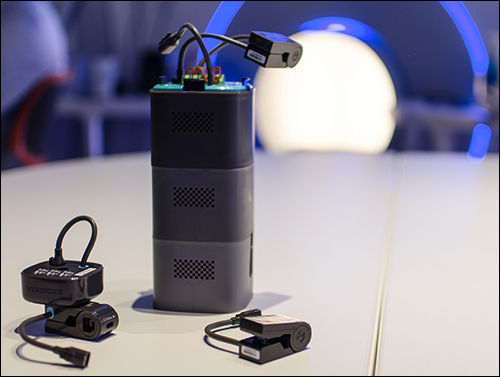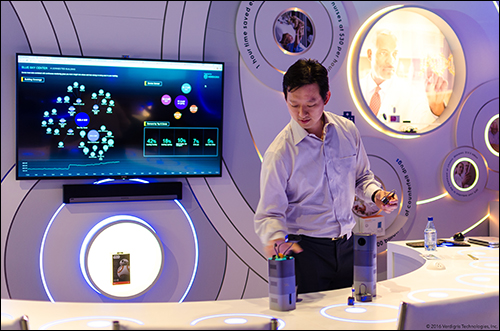Aug 31, 2016In 2010, Mark Chung received a surprise in the mail: a $550 electric bill. That was an increase of nearly 225 percent over previous bills, and during a month when his house was empty for an entire week. Naturally, Chung called his utility company to inquire about the source of the spike. But the firm said it had no idea why this had occurred. After much trial and error, Chung decided to try to root out the cause himself, by buying kilowatt meters to plug in between all of his major appliances and their respective wall outlets. Because the meters were not networked, however, tracking the data they collected was time-consuming and inefficient.
"I thought, 'How many other people are challenged with this?'" Chung says. "This was at a time when the Internet of Things was just developing. [Networked] sensors could be used to pull data and streamline the process of getting information from a building."
That question sparked an idea that evolved into Verdigris, the energy-management platform for buildings and factories that Chung co-founded with Jonathan Chu, a former coworker of his at Netlogic (later sold to Broadcom). The platform tracks the precise amount of energy that each device or appliance—chillers, fans, washing machines and so forth—consumes. But because each device or appliance generates an electrical signature when it is in use, the Verdigris platform also employs artificial intelligence to learn how a given piece of equipment operates and where small changes in its electrical signature are correlated with an attribute of that device's motor. Changes in the signature, found through a process called frequency domain analysis, can be caused by physical components in the equipment being out of specification. For example, variations in a motor's speed, the alignment of its rotor bars and windings, or electrical resistance of the windings can be spotted through this analysis. "Usually, a fluctuation [in the electrical resistance of windings] means that the insulation of the windings has worn out," Chung explains, "and is causing the motor to suffer from uneven current in the various rotors."
Using the lessons he learned while trying to monitor energy usage in his own home, Chung says he knew that tracking energy consumption at the plug level was not a viable solution. Instead, Verdigris uses sensors that are clipped onto circuit breakers and wired to a cellular gateway. Data culled from the transformers is forwarded to cloud-based software for analysis. But here it is also integrated with weather data and electricity pricing data from the local utility, enabling Verdigris to alert building managers to periods of high electricity demand on the electrical grid—when rates tend to rise. The software might suggest temporarily adjusting certain equipment, such as furnaces or chillers, in order to reduce power consumption and avoid entering higher pricing tiers during periods of high demand. Or, simply to reduce energy consumption irrespective of energy pricing, a building manager might want to know that predicted temperatures outside a building are expected to meet the cooling needs inside. When that happens, he or she can shut off compressors and use outside air to cool the premises.
Yesterday, Verdigris announced Einstein, the latest generation of its IoT platform. The Einstein platform includes the Verdigris sensor, for use with a circuit with a maximum capacity of 60 amps (for a circuit with larger current capacity, a third-party sensor is used along with an adapter module that Verdigris makes). In an electric panel, a single sensor is clamped onto each circuit, and the sensors are daisy-chained together, leading to the Einstein data transmitter, which houses the wires from the sensors and connects them to a Verdigris computing device connected to a 4G gateway. According to Chung, the Einstein hardware is easier and faster to install than Verdigris' previous hardware, known as Dalton. In addition, he says, because the Dalton lacked an integrated cellular radio, it had to be attached to an external Wi-Fi or cellular modem via a USB extension cable.
The Einstein platform supports two discrete applications for building managers. One, called Tracker, generates timely warnings regarding forecasted periods of high energy demand or issues with machine health, based on analysis of the machine's electrical signature. Conversely, if it detects an unusually high amount of energy consumption within a certain part of the building outside of normal business hours, the Tracker app will issue an alert to building managers. The other app, known as Dashboard, is designed for building managers to look at the performance of equipment over time, with weekly and monthly reports. This can be used to help them adjust settings in their heating, ventilation and air-conditioning (HVAC) systems, or identify how and when other highly energy-consumptive building systems, such as manufacturing equipment, dishwashers or laundry facilities, are being operated, in order to run them most often during times when electricity prices are low.
Thus far, Verdigris' technology has been installed at approximately 100 buildings, primarily hotels, manufacturing facilities and hospitals. The company's customers include Hyatt, Starwood, Marriott and Intercontinental Hotels, while those in the manufacturing industry include Flextronics, JBL, Honeywell and Jabil, a contract electronics manufacturer that operates 57 factories in 33 countries. Jabil—which helped Verdigris launch the Einstein platform on Monday at a press event held at its Blue Sky Center, an innovation lab in San Jose, Calif.—also manufacturers the clamps that are attached to circuit breakers. In addition, Jabil has invested in Verdigris, which has raised $9 million in venture funding. (Other investors include Stanford StartX Fund, Founder.org Capital and DCVC.)
"Jabil has been working with Verdigris for two years as a manufacturer and has been using its technology for six months, both at the Blue Sky Center and at a production center in Livingston, Scotland, where we make battery systems and electronics," says David Kipling, Jabil's VP of corporate investments. "The technology has absolutely paid for itself and more," he adds, by providing insights into machine health, and by sending alerts about upcoming peak demands that allow facility managers to roll back power usage to avoid rate spikes. "Our intention now is to roll [the Verdigris hardware] out to further facilities," Kipling states.
Some manufacturers already mount sensors directly to equipment and use them to monitor machine health, but Verdigris says it can go toe-to-toe with those systems based on the granularity of its sampling and analysis of the device's electrical signatures. For example, Verdigris uses frequency domain analysis to look for small variations in signatures at narrow frequency bands. It can tie these abnormalities to potential mechanical problems involving a specific piece of equipment, based on what it knows the signatures coming from that equipment should look like during normal operation. So a building manager might receive an alert on his or her phone, through the Tracker app, that says "Verdigris has detected electrical activity that may indicate motor damage in Condenser Pump 3 in the chiller plant. Look for a broken rotor bar," along with the timestamp of when the abnormality was detected.
Chung declines to provide specific pricing information, but says the initial hardware costs can be as low as a few hundred dollars for a small deployment. Customers also pay an ongoing subscription service fee.
Potential savings—resulting from the use of Verdigris' data to reduce energy consumption and adjust operational settings of specific equipment to avoid spikes in energy costs—can be significant. But sometimes, the savings are not strictly financial. When the Verdigris system detected a load imbalance from a dishwasher at a four-star San Francisco hotel, for instance, the hotel investigated and realized that a heating element in the machine—which the city's health department had inspected just weeks prior—was broken. In this case, the issue was not that the machine was using too much energy, but that gourmet cuisine was being served on unsanitized dishes.


